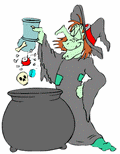|
Food Additives:
|
Food Additives: M'm, M'm Bad.
 |
List of ingredients. That's the first thing I, as a nutrition professional, read on a nutrition label.
I don't even look at the fat grams or calories or cholesterol content unless the ingredient list passes muster.
Wanna know what I'm looking for?
The absence of food additives, whether they be
- food dyes
- artificial flavorings
- food coloring, or
- preservatives
The human body is a finely tuned machine! At the cellular level, trillions of interactions occur each day. Yet we think nothing of introducing foreign substances into our bodies. We care more about the carb content of our food than what's actually in it.
Ever stop to think about how that banana cheesecake yogurt (with only 100 calories of course) can actually taste like banana cheesecake?
Or how Sugar Free Strawberry Jello (many dieters' favorite "free food") has such a pretty red color, delicious strawberry flavor and less than 10 calories?
Food additives are what make it all possible.
They're used to preserve flavor or improve taste and appearance (forget about health!) and can be divided into several categories based on their purpose:
Acids are added to make flavors "sharper", and also act as preservatives and antioxidants. Common food acids include vinegar, citric acid, tartaric acid, malic acid, fumaric acid, lactic acid.Acidity regulators are used to change or otherwise control the acidity and alkalinity of foods.
Anticaking agents keep powders such as milk powder from caking or sticking.
Antifoaming agents reduce or prevent foaming in foods.
Antioxidants such as vitamin C act as preservatives by inhibiting the effects of oxygen on food (and can be beneficial to health).
Bulking agents such as starch are additives that increase the bulk of a food without affecting its nutritional value.
Food colorings are added to food to replace colors lost during preparation, or to make food look more attractive.
Color retention agents are used to preserve a food's existing color.
Emulsifiers allow water and oils to remain mixed together, as in mayonnaise, ice cream, and homogenized milk.
Flavors are additives that give food a particular taste or smell, and while they may be derived from natural ingredients they are often created artificially.
Flavor enhancers enhance a food's existing flavors. They too may be extracted from natural sources or created artificially.
Flour treatment agents are added to flour to improve its color or its use in baking.
Humectants prevent foods from drying out.
Tracer gases in packaging prevent foods from being exposed to air, extending shelf life.
Preservatives prevent or inhibit spoilage of food due to fungi, bacteria and other microorganisms.
Stabilizers, thickeners and gelling agents, like agar or pectin (used in jam for example) give foods a firmer texture. While they are not true emulsifiers, they help to stabilize emulsions.
Sweeteners are added to foods to make them extra yummy. Artificial sweeteners are added for yumminess and to keep calories artificially low.
Thickeners are substances which, when added to processed food, increase viscosity without substantially modifying other properties.
What's the big deal about food additives?
Well, many are poorly tested and possibly dangerous!
(Wanna know which ones? See this Alphabetical List of Food Additives: Which Ones are Safe, Poorly Tested, or Possibly Dangerous?)
One class of food additive, food dyes, have been shown in studies to have adverse affects on lab animals and are believed by many medical professionals to cause Attention Deficit Disorder (ADD) and other forms of hyperactivity.
(Read more scientific studies and medical papers that offer evidence of the malevolent role chemical additives play with our health and behavior.)
|
Unfortunately chemical cuisine is standard fare thanks to our dependence on processed foods. Food additives and foods with poor nutritional value go hand in hand.
My professional advice?
Take your food seriously. Avoid food additives by:
- Eating more whole foods
- Reading ingredient lists on food labels
- Shopping at natural food stores. They have a wider selection of foods free of chemicals. But never assume...always read the nutrition label!
Cutting back on your additives: just one more step on your path to healthy eating!
Back to Personal Nutrition Guide Home.





